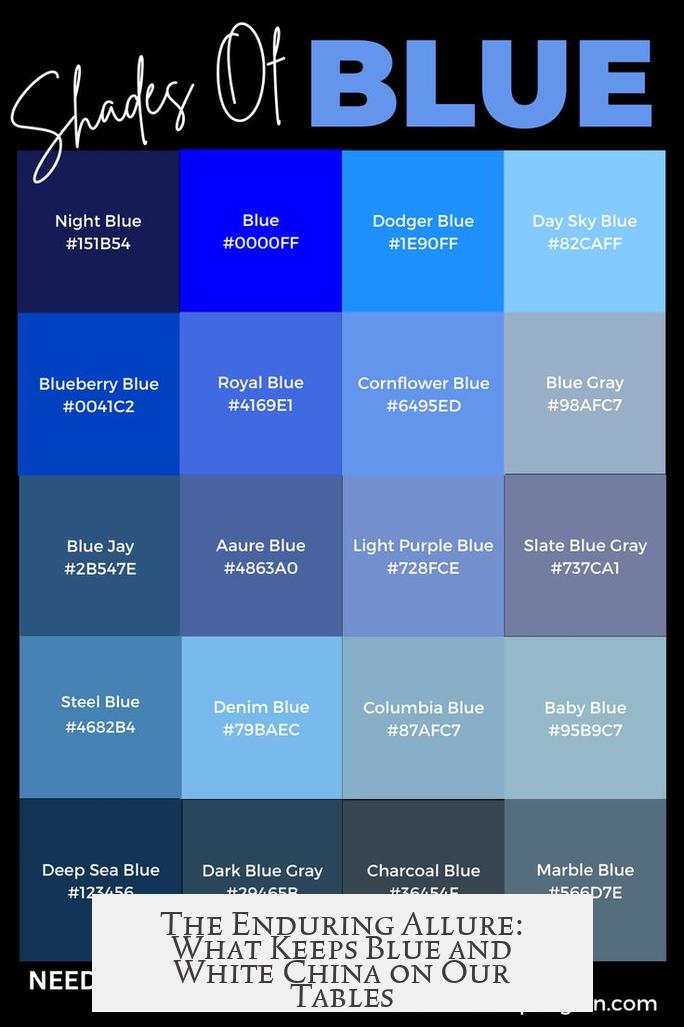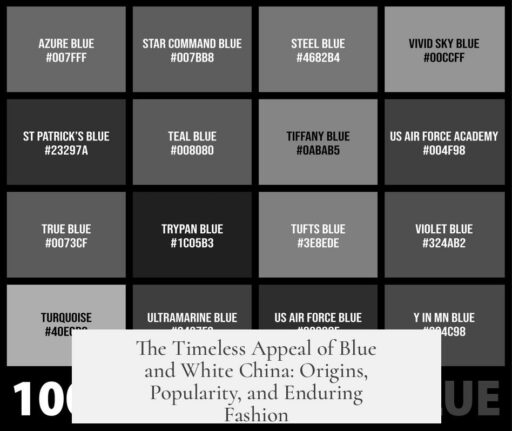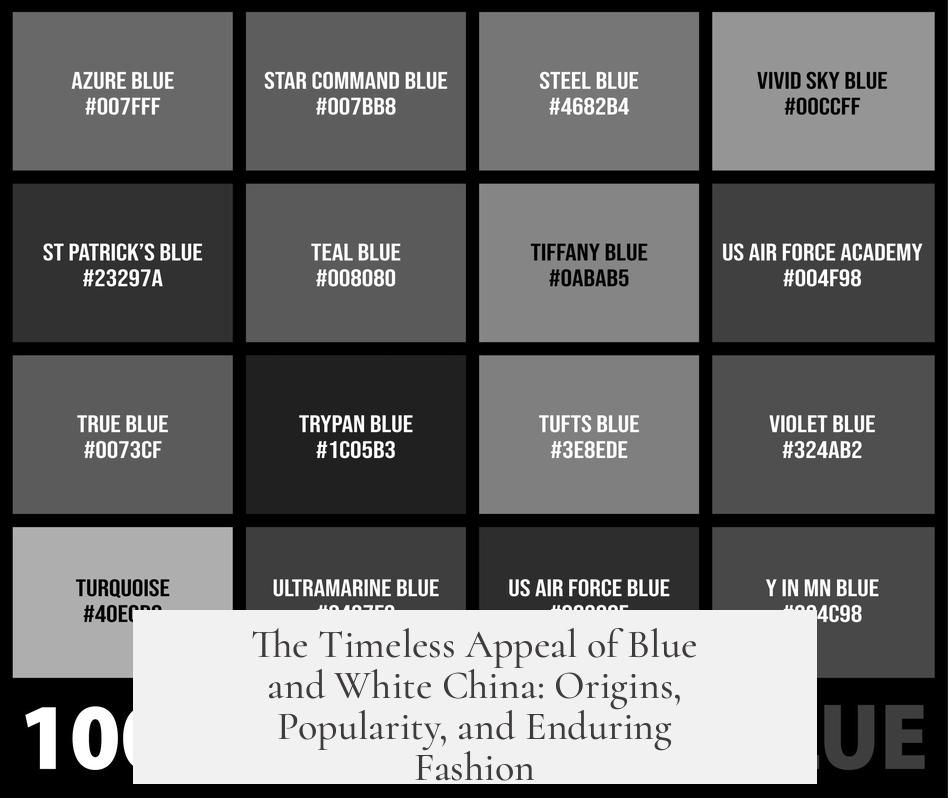Blue and white china gained widespread popularity due to its association with high-quality Chinese porcelain, which became the standard of fine ceramics in Europe from the late medieval and early modern periods. This style endures because it represents a blend of technical excellence, aesthetic appeal, and cultural significance.
Chinese porcelain is renowned for its pure white body made from kaolin clay and a feldspathic mineral called pé tun tse. The glaze is also feldspathic, giving the surface a glass-like hardness without the tiny cracks found in other glazes like tin or lead-based ones. The blue color used in decoration comes from cobalt oxide, which withstands the high firing temperatures of porcelain production. This true porcelain, with its smooth white surface and vivid blue decoration, was exotic and highly prized across Europe.
European potters initially could not replicate Chinese porcelain because they lacked access to the necessary kaolin deposits and had not mastered the firing techniques. Early European ceramics were either soft earthenwares or stonewares which did not achieve the same purity of white or durability. When European merchants, notably the Dutch East India Company and later the British East India Company, imported Chinese blue and white porcelain in vast quantities from the 16th century onward, this elevated its status and demand.
With the high cost and limited availability of imported Chinese porcelain, European potters strove to imitate the style. This led to the creation of refined earthenwares and stonewares in Europe, such as Dutch Delftware, English creamware, pearlware, and ultimately whiteware. Many of these products aimed to replicate the white body and blue decoration of Chinese originals.
- Delftware: Tin-glazed earthenware with blue decoration inspired by Chinese designs. It provided a more accessible alternative but lacked porcelain’s durability.
- Creamware (1762): Invented by Josiah Wedgwood, this refined earthenware had a creamy glaze and was a stepping stone to whiter bodies.
- Pearlware (1775): An improvement on creamware incorporating calcined flint to create a whiter base. Its glaze was tinted bluish-white by adding small amounts of cobalt oxide, making blue decoration both vibrant and affordable.
- Whiteware (1800): The closest European imitation of pure white porcelain, it became the foundation for many popular patterns, including the famous Willow Pattern still common today.
Cobalt was the cheapest pigment available for decoration, contributing to blue’s dominance. Other colors existed but were typically more costly, so blue became the default choice for mass-produced ceramics. The transfer printing technique further lowered costs and standardized designs, reinforcing blue and white’s popularity.
The enduring appeal of blue and white ceramics results from this historical trajectory. Blue and white china symbolizes craftsmanship, a link to the rich Chinese porcelain tradition, and affordability through European manufacturing innovation. Patterns like Willow became iconic, embedding the style deeper into Western culture.
Trade routes established in the 16th century greatly increased Chinese porcelain’s availability in Europe. Prior to this, only limited quantities arrived via Middle Eastern intermediaries. The East India companies’ importation expanded access, stimulating European potters to imitate and adapt the style.
| Aspect | Explanation |
|---|---|
| White Porcelain Body | Made from kaolin and pé tun tse; pure, hard, and glass-like surface rare in European ceramics initially |
| Blue Decoration | Cobalt oxide pigment resists high firing, cheapest colorant, vibrant and durable |
| European Imitations | Refined earthenwares and stonewares aimed to match Chinese porcelain’s white and blue aesthetic |
| Trade Impact | Exported Chinese porcelain created demand and aspiration among Europeans |
Blue and white china stands out because of its technical qualities and affordability combined with a rich cross-cultural history. Its iconic designs have been reproduced for centuries, cementing this style as a staple of fine and everyday ceramics.
- Chinese porcelain’s pure white body and cobalt blue decoration set a standard unmatched initially in Europe.
- European potters imitated blue and white styles to meet demand for affordable yet elegant ceramics.
- Cobalt blue was widely chosen for its cost-effectiveness and lasting vibrant color.
- Trade with China fueled the style’s popularity and inspired enduring patterns still produced today.
Why Was Blue and White China So Popular Compared to Other Colors — And Why Does This Style Endure Today?

The short and sweet answer is this: Blue and white china became the gold standard in ceramics because Chinese porcelain dazzled Europe with its pure white base and vibrant blue cobalt decoration, something unmatched in quality or style. This combination of aesthetics, craftsmanship, and exotic allure made it a coveted treasure, setting trends that lasted centuries and still captivate us today.
But let’s unpack that further. Why blue? Why white? And how did this style embed itself so deeply in Western culture? Buckle up, because the history behind blue and white china holds lessons about art, science, culture, and a bit of human obsession with the coolest stuff from afar.
Chinese Porcelain: The Original Blue and White Superstar
Back in the late medieval and early modern periods, Chinese porcelain was the *bee’s knees* of ceramics. Europeans couldn’t rival its fine white surface and striking blue decoration — a signature combination crafted using cobalt oxide. The raw materials matter: the porcelain was made from a special white clay called kaolin and a feldspathic mineral known as pé tun tse, firing at high temperatures to achieve a glass-like smoothness.
This fired strength was *no joke*. Unlike European pottery which often crazed (developed those pesky tiny cracks) or had softer finishes, Chinese porcelain was tough and gleaming. It carried a purity and elegance that screamed luxury. On top of that, the oriental blue designs — often intricate flowers, landscapes, or mythical creatures — added visual pop.
One can’t overlook the mystique factor here. European traders brought these gleaming treasures from China via the Silk Road and later through extensive maritime routes powered by the Dutch and British East India Companies. Imagine having something so rare on your table that it felt like a ticket to a faraway magical place.
Why Blue? Why Cobalt?
If you ever asked, “Why blue exactly?” the answer dips into both practical and aesthetic reasons. Cobalt was a powerful pigment that could withstand the high firing temperatures needed for porcelain without fading or distorting. Other colors like red were possible but less common and often trickier to apply consistently. Blue, therefore, dominated because it was reliable and visually stunning against the white canvas.
Plus, blue on white is a classic combo that our eyes love — crisp, clear contrasts that highlight designs elegantly. This wasn’t just accidental; artisans figured out that cobalt blue decorations shimmered best on that pure white glaze.
European Attempts to Keep Up — And How That Cemented the Style
Europeans were so smitten with Chinese porcelain that they tried copying it for centuries. The challenge? No Europeans initially had access to the same pure kaolin clay, and their firing techniques lagged. Early efforts produced soft, imperfect “porcelaneous” wares. They made things like tin-enamel Delftware, which had a white or bluish glaze but was prone to glaze flaking and a less glassy finish.
Innovators like Josiah Wedgwood in England moved the game forward by inventing Creamware and later Pearlware in the 18th century. Pearlware specifically added calcined flint to achieve a whiter body, with cobalt oxide lending a blue tinge to the glaze — a nod to the beloved Chinese aesthetic.
As technology improved, “whiteware” emerged around 1800 — not quite porcelain but beautifully white earthenware, much closer to the original Chinese look. In these wares, blue decoration reigned supreme once again because it was the most affordable. And affordable meant accessible. More people could now enjoy the stylish and “exotic” feel that blue and white china offered.
That takes us to why blue and white patterns like the famous Willow Pattern remain popular: they evolved through centuries of imitation, affordable manufacturing, and tradition, cementing blue and white as the ceramic world’s “classic uniform.”
The Enduring Allure: What Keeps Blue and White China on Our Tables?

Now that the industry is global and ceramic colors and techniques are endless, why does blue and white china still hold its charm?
- **Timeless Appeal:** The stark contrast between blue and white is universally pleasing and fits various decor styles, from rustic farmhouse to sleek modern.
- **Historical Gravitas:** Owning blue and white china feels like touching a slice of art history, connecting us with the Silk Road, European artistry, and centuries of craftsmanship.
- **Cultural Iconography:** Famous patterns, especially Willow, come loaded with stories and cultural symbolism. It’s not just plates; it’s narrative-rich decor.
- **Versatility:** It pairs well with almost any color palette, making it a safe yet stylish choice.
Ever noticed how designers or collectors often return to blue and white pieces? They’re invested not just in the look but the heritage. It’s like fashion’s “little black dress” for dinnerware.
A Bit of Reflection: Is Blue and White Ceramics Just a Trend That Refuses to Die?
Trends typically flare and fade, yet blue and white china stands strong. Could it be that all the stuffiness around fancy dishes gets diffused by this simple color scheme that’s easy on the eyes, fits with history, and, frankly, looks good in photos? (Yes, it’s Instagram-ready.)
Also, since it was the first porcelain style Europeans encountered and only relatively recently did porcelain production become widespread in the West, blue and white china carries a kind of ancestral “wow” factor. Its dominance isn’t random — it’s deeply rooted in centuries of admiration and imitation.
Think about it: How many other ceramic colors have inspired decades of global trade, innovation, and cultural exchange? How many have a story that reaches back to empires and explorers?
Practical Tips for Collectors and Enthusiasts
If you’re intrigued by blue and white china and want to start or expand your collection, keep these tips in mind:
- Research the Origins: Authentic Chinese porcelain from the Ming or Qing dynasties differs vastly from 18th-century European imitations. Knowing the provenance adds value and interest.
- Look Beyond Classics: Many makers globally produce beautiful blue and white wares. Explore Delftware, English creamwares, and modern interpretations to find your favorite style.
- Mix it Up: Pair blue and white china with simple wooden or neutral-colored table settings to offer contrast and highlight its elegance.
- Preserve Your Pieces: The glaze helps protect, but careful handling ensures your heirlooms last for generations.
In short, blue and white china is more than just a color combo. It’s a cultural phenomenon birthed by superior materials, brilliant craftsmanship, and decades of global trade shaping tastes and techniques.
Next time you pick up a blue and white porcelain cup or plate, remember: you’re holding a slice of art, history, and human ingenuity — all painted in cobalt blue.
Why was blue cobalt used in Chinese porcelain decoration?
Blue decoration on Chinese porcelain comes from cobalt. This pigment withstood high firing temperatures without fading. Its strong contrast against white clay created striking designs. This made blue a practical choice for durable, visible decoration.
Why did Europeans prefer blue and white ceramics over other colors?
European potters found blue pigment cheaper than others. Blue was easy to apply and remained vivid after firing. Additionally, blue and white styles imitated prized Chinese porcelain, adding to their popularity.
How did Chinese porcelain influence European pottery styles?
Chinese blue and white porcelain set a standard Europeans wanted to emulate. Early European attempts focused on copying the pure white body and blue decoration. This led to innovations like Delftware and Pearlware with similar blue patterns.
What made blue and white china an enduring design through centuries?
Blue and white china became tradition because it was affordable, visually appealing, and associated with status. Patterns like the Willow design remain popular due to their historical roots and timeless style.
Why were European white ceramics rarely as pure white as Chinese porcelain?
Europe lacked access to pure kaolin clay initially. This made their wares less white. Over time, techniques improved, reaching near-white bodies in the 19th century. Still, blue decoration was preferred for its cost and its historical connection to Chinese porcelain.




